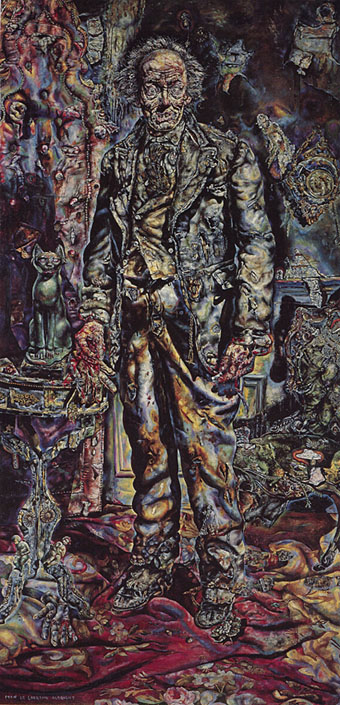 |
| The Picture of Dorian Gray, Ivan Albright, 1945 The Art Institute of Chicago |
In the movie, filmed in black and white, there are a few moments of color. The first comes when we get to see the painting of Dorian that his friend, Basil Hallward, had just completed. It shows a young gentleman who is self-assured, talented, wealthy, upper-class, and flawless.
 |
| Portrait of Dorian Gray, painted by Henrique Medina for the movie The Picture of Dorian Gray (1945) |
Dorian's infatuation with Sibyl Vane is a good example of his incorporating Lord Henry's philosophy into his own life. His infatuation with Sibyl and then his rejection of her at the advice of Lord Henry, in the guise of a test, shows that Dorian doesn't comprehend, although he might still care at this point, what he represented to Sibyl. She is desperate for a way to leave her life of singing in the little club, and her mother seems to constantly tell her that she deserves better. When "better" finds her and Dorian offers her a way out, she snatches it eagerly despite the inequality of their situations. But Sibyl is not willing to go against her moral standards to be with Basil and certainly does not expect to be rejected so utterly.
The next shocking flash of color comes when we again see the portrait. Absorbing all of the vices of the model, the painting has become gross, decayed, and terrifying. We haven't seen Dorian commit many crimes during the story and movie; we only know that 18 years have passed since Sibyl's death. We can only imagine the atrocities he has committed over the years. Of course, the horror of his murdering his friend Basil on top of the seduction of young innocent Gladys Hallward, who naively things that just because Dorian is so good looking, the things people say about him can't be true, are only a small sample of Dorian's vices. But the ending of the story proves that there can be redemption after all but at what price? This painting has come to represent his soul, what he has become deep inside and hides from the world. Can anyone this ugly and horrifying inside be capable of caring for anyone but himself? Will Gladys end up like poor Sibyl?
I thought Hurd Hatfield was a good choice for Dorian. I was particularly struck by how mask-like his face is throughout the movie, so smooth and wrinkle-free. But to have a face like this, it would imply that this person also doesn't show any emotion. Smiles cause wrinkles, too, and Hurd as Dorian doesn't ever seem to smile or laugh. Does he enjoy his life? Perhaps he is not capable of it.
If you haven't seen this movie, I recommend it but not as a substitute for the novel by Oscar Wilde. That is a classic of literary horror and shouldn't be missed.
The Albright painting was painted with the Medina portrait as the base. I wish the Art Institute had both of them side by side to show the contrast. Without the other, Albright's painting is a ghoulish painting that exemplifies a life spent in evil pursuits, or maybe it is just another zombie picture. Nasty but interesting. We don't understand the message of the book without the "original" to compare to it.
If you haven't seen this movie, I recommend it but not as a substitute for the novel by Oscar Wilde. That is a classic of literary horror and shouldn't be missed.
The Albright painting was painted with the Medina portrait as the base. I wish the Art Institute had both of them side by side to show the contrast. Without the other, Albright's painting is a ghoulish painting that exemplifies a life spent in evil pursuits, or maybe it is just another zombie picture. Nasty but interesting. We don't understand the message of the book without the "original" to compare to it.
No comments:
Post a Comment
Note: Only a member of this blog may post a comment.